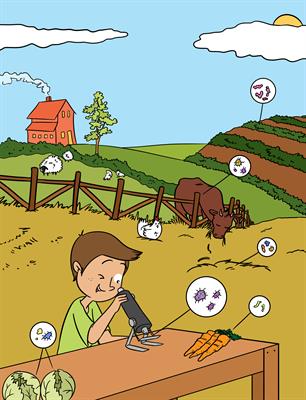
Tiny Microbes, Big Yields: The Future of Food and Agriculture
Collection Editors
Phillip Myer, Liesel SchneiderViews
210,276 viewsParticipating Sections
Submission Deadline
Closed
Articles

Biodiversity
18/01/2022
What Are the Small Lumps I See on Some Plant...
Authors
Fede Berckx, Katharina Pawlowski
Biodiversity
28/10/2021
Giving Good Bacteria to Chickens to Keep Humans...
Authors
Mary Mendoza, Rizwana Ali, Natalie Roberts, Lauren Boop...
Biodiversity
16/08/2021
Rescue Rangers: How Bacteria Can Support Plants
Authors
Rocío Hernández-león, Yunuen Tapia-Torres
Biodiversity
13/08/2021
Who Feeds The Plants? Microbes!
Authors
Aline Lacaze, Antoine Zboralski, David L. Joly
Human Health
25/02/2021
Bacteria in the Reproductive Tract: They Are Not...
Authors
Taylor B. Seay, Brooke A. Clemmons, Phillip R. Myer, Kyle J...
Biodiversity
15/10/2020
One Type of Soil Bacteria Performs Two Important...
Authors
Lauren S. Mckee
Biodiversity
25/09/2020
Microbes Help Predict More Efficient Cattle
Authors
Brooke A. Clemmons, Phillip R. Myer
Biodiversity
04/09/2020
Getting Big Cows by Feeding Their Tiny Microbes
Authors
Brooke A. Clemmons, Emma Hernandez-Sanabria
Biodiversity
21/05/2020
Agrobacterium: Soil Microbe, Plant Pathogen, and...
Authors
Ryan T. Weir, Johnathan J. DalzellAbout this collection
Our world is made up of countless tiny living beings. There are so many of them, that they make up the largest number of living beings on the planet. These microscopic organisms, called microorganisms or microbes, cannot be seen with the naked eye. We encounter them daily and we interact with them through the air we breathe, the food we eat, and the natural processes within our own organ systems. Microbes have evolved with life on Earth to be important for its survival. They act as food for plants and animals, help humans and animals digest food, break down dead material, and even serve as guardians against bad microbes. Whether we realize it or not, humans rely on microbes to help make the food we eat every day, and understanding how they work helps us to improve our foods and agriculture.It is amazing to examine how well microorganisms are incorporated into the food we eat, the plants we grow, and the animals we raise. Microbes help ferment foods to make products like cheeses and breads. They work in the soil to provide nitrogen to plants which helps them grow better. Special microbes live in the stomachs of cattle and sheep that allow them to digest grasses that humans cannot eat. Additionally, the energy produced from the microbial digestion of these grasses helps produce meat and milk. However, as with everything, we must take the good with the bad. Although many microbes are helpful, some are harmful and can cause illness. These “bad bugs” must be monitored to ensure they do not enter our food supply. The challenge is to interpret the ways the microbes are positively and negatively impacting food and agriculture and to untangle their complex network to promote improved and more efficient approaches to feed the world.
This collection of articles focuses on understanding more about microbial communities, biodiversity, and their relationships with food and agriculture. This includes, but is not limited to, food and animal production, animal health, food safety, crop safety and production, and agricultural sustainability through microbial-based approaches. What we can learn about these tiny living beings can help provide safe, nutritious, and sustainable food to a growing human global population.
Would you like to submit to this collection?
For researchers interested in submitting to this Collection, please consult our author guidelines and check that you have all the essentials included before submitting














